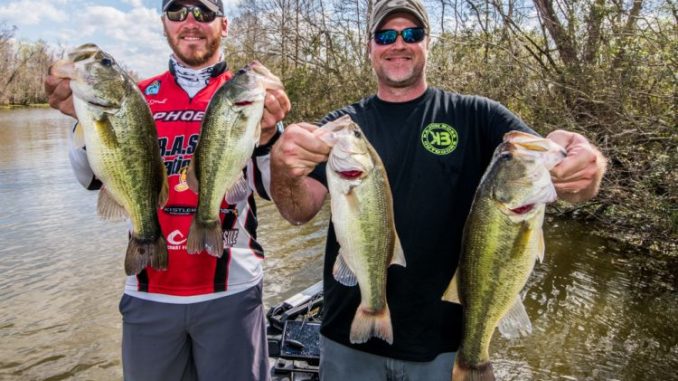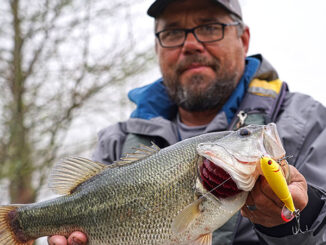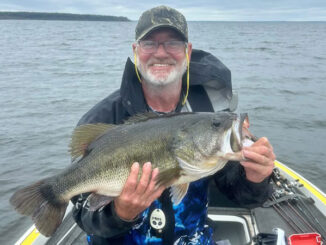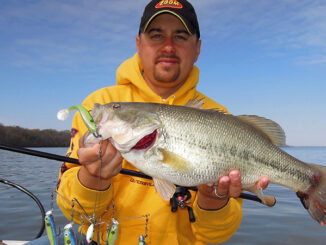
Another wave of spawners waiting to move up, Sumrall says
After the frigid winter, the expectation when we left the landing Monday morning was that we’d find bass sucked up tight to the banks doing their spawning business.
By the end of the trip, however, only one Atchafalaya Basin bass showed signs that it was waiting to move up to bed.
“Another wave will definitely move up on the next full moon,” New Iberia Bassmaster Elite Series pro Caleb Sumrall said. “But there are a lot of fish that have finished.”
So the key to catching limits in the Basin the next few weeks will be flexibility.
Sumrall and buddy Marcus Curry of Kajun Boss Outdoors ended up putting together a 13- or 14-pound stringer by targeting cover farther out from the banks of canals.
Curry caught several fish on one of his company’s Gorilla Blades spinnerbaits, while Sumrall pitched and punched every available piece of structure.
Every fish he caught yesterday came off the D-Bomb, while Curry added a few spinnerbait bass.
Surmall kept two rods rigged with the creature bait on his deck. One lure was topped with a heavy, pegged weight and one included a light, unpegged sinker.
The cover he targeted dictated the proper choice.
When pitching stumps, laydowns and flooded cypress trees, he grabbed the 1/4-ounce unpegged rig.
“I feel like it lets the bait sit off the bottom just a little bit,” Sumrall said. “Sometimes that will get them to bite.”
He said fish will pull up to any wood cover to set up spawning shop, but he said there are key spots he makes sure he works over thoroughly.
“I like dominant cypress trees that stick out a little bit and those on points,” Sumrall explained.
But when he crossed a pad of water pennywort, he traded up to the pegged rig so he could punch the mat.
Obviously, spawning fish will be in dead-end canals.
Sumrall said he looks for swirls and mud clouds to clue him into the presence of bedding bass in the stained waters of the Basin.
“You aren’t normally going to see fish,” he explained.
Absent one of those visual keys, however, the angler keeps on the move until he puts a fish or two in the boat.
“I cover a lot of water — the opposite of what you’re supposed to do,” Sumrall explained. “When I catch a few fish, then I slow down and concentrate on that stretch.”
He likes banks with a little undercut to offer a bit of water depth, as opposed to those that gradually slope into the middle of the canal.
When focusing on post-spawn fish, he moves off the banks — and starts working his way out of the back ends of the canals.
“I start looking for muddy, moving water near the dead-ends,” Sumrall said. “You can catch fish moving out of the dead-ends to well-oxygenated water.”
He explained bass will set up in waterways offering some sluggish current; they won’t be moving back into the main, rolling waters just yet.
But when you find post-spawn bass they’re looking to fatten up after the rigors of the spawn.
“I target anything irrigular on a long, straight bank,” Sumrall said. “Anything that’s a little bit different.”
He loves to flip, but he’ll also use a spinnerbait or square-bill.
Drains really start working into his equation.
“Any time you find a drain, you want to fish it,” Sumrall said. “You fish the two points of the drain and the downcurrent side of the drain. A drain can hold a vast number of fish.”
He works active drains with spinnerbaits and square-bills first, and then flips soft-plastics to ensure he’s not missing anything.
“You can’t spook fish in a drain,” Sumrall said of the moving baits. “They’re there to feed.”


